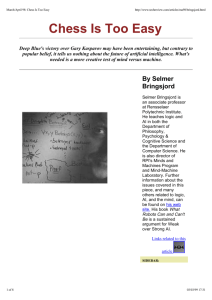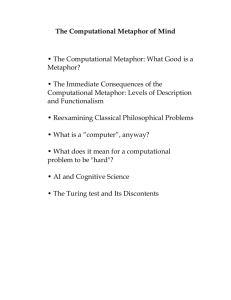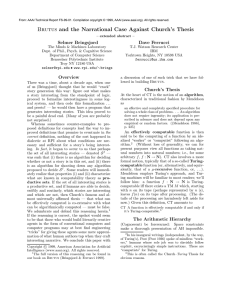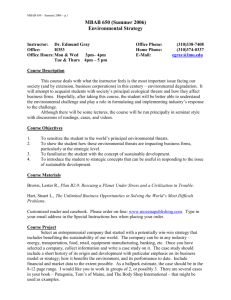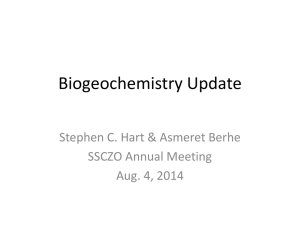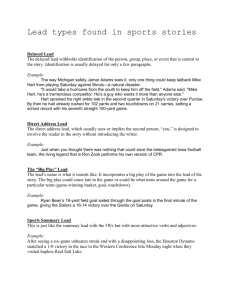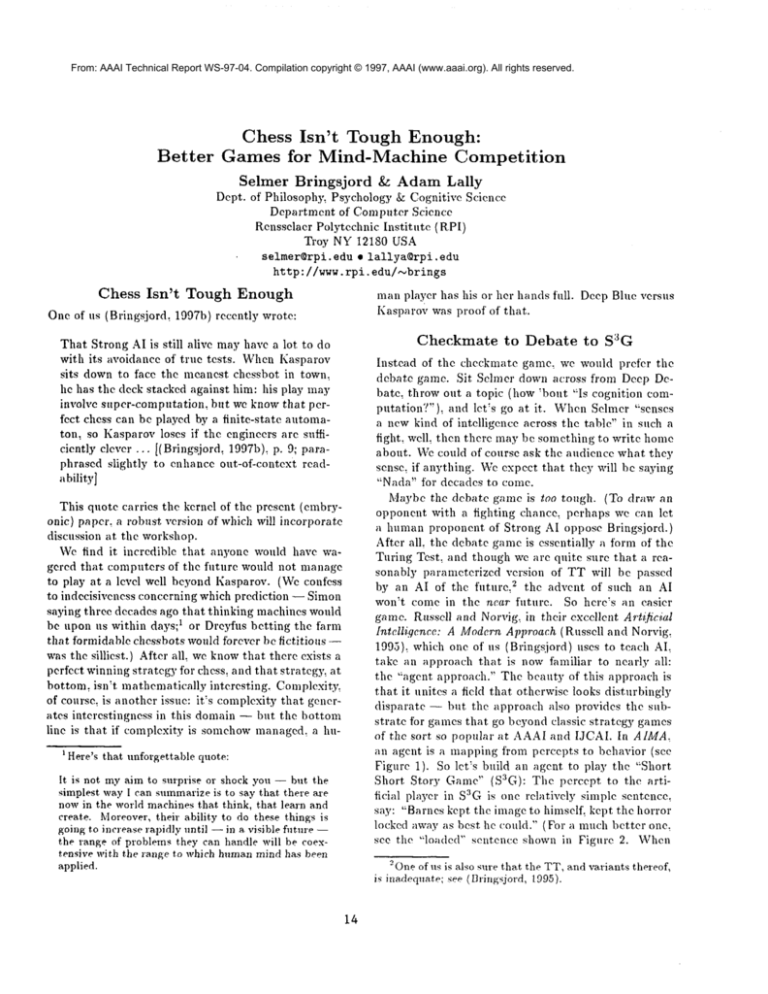
From: AAAI Technical Report WS-97-04. Compilation copyright © 1997, AAAI (www.aaai.org). All rights reserved.
Chess Isn’t
Tough Enough:
Games for Mind-Machine
Competition
Better
Selmer Bringsjord
&: Adam Lally
Dept. of Philosophy. Psychology & Cognitive Science
Department of Computer Science
Rcnssclacr Polytechnic Institute
(RPI)
Troy NY 12180 USA
selmer@rpi,edu ¯ lallya@rpi,edu
http://www,rpi. edu/-~brings
Chess Isn’t
One of us (Bringsjord.
Tough Enough
1997b) recently
man player has his or her hands full.
Kasparov was proof of that,.
wrote:
Checkmate
That Strong AI is still alive may have a lot to do
with its avoidancc of true tests.
When Kasparov
sits down to face the meanest chcssbot in town:
hc has the deck stacked against him: his play may
involve super-computatiom but we know that perfect chess can be played by a finite-state
automaton: so Kasparov loses if the engineers arc suificiently clever ... [(Bringsjord: 1997b), p. 9; paraphrased slightly
to enhance out-of context readability]
This quote carries the kernel of the present (embryonic) paper, a robust version of which will incorporate
discussion at the workshop.
We find it incredible
that anyone would have wagered that computers of the future would not manage
to play at a lcvcl well beyond Kasparov. (We confess
to indecisiveness concerning which prediction -- Simon
saying three decades ago that thinking machines would
be upon us within days; 1 or Dreyfus betting the farm
that formidable chessbots would tbrever be fictitious
-was the silliest.)
After all we knowthat there exists
perfect winning strategy for chess: and that strategy, at
bottom, isn’t mathematically interesting,
Colnplexity,
of course~ is another issue: it:s complexity that generates interestingness
in this domain -- but the bottom
line is that if complexity is somehow managed, a hu1 Here’s that unforgettable quote:
It is not. my aim to surprise or shock you -- but the
simplest way I can summarize is to say that there axe
now in the world machines that think, tha.t lem’n and
create. Moreover, their ability to do these things is
going to increa,se rapidly until -- in a, visible future -the range of problems they can handle will be coextensive with the range to which human mind has been
applied.
to Debate
Deep Blue versus
to SaG
Instead of the checkmate game, we would prefer the
debate game. Sit Schner down across from Deep Dcbatc: throw out a topic (how ’bout "Is cognition computation?"),
and let’s go at it. When Sehncr "senses
a new kind of intelligence
across the table" in such a
fight, well then there may be something to write home
about. Wc could of coursc ask thc audience what they
sense, if anything. Wc expect that they will bc saying
"Nada" for decades to come.
Maybe the debate game is too tough. (To draw an
opponent with a fighting chance, perhaps we can let
a human proponent of Strong AI oppose Bringsjord.)
After all, the debate game is essentially
a form of the
Turing Test, and though wc arc quite sure that a reasonably paramcterizcd
version of TT will be passed
by an AI of the future.. ~ the advent of such an AI
won"t come in the near future. So hcl’e~s an easier
game. Russell and Norvig, in their excellent Ar’hificial
Intelligence:
A Modern At)l)roaeh (Russell and Norvig¢
1995): which one of us (Bringsjord)
uses to teach
take an approach that is now falniliar
to nearly all:
the "agent approach." The beauty of this approach is
that it unites a field that otherwise looks disturbingly
disparatebut the approach also provides the substrate tbr games that go beyond classic strategy games
of the sort so popular at AAAI and IJCAI. In AIMA~
an agent is a mapping from percepts to behavior (see
Figure 1). So let’s build an agent to play the "Short
Short Story Game" (SAG): The percept to the artificial player in SaG is one relatively simple sentence,
say: "Barnes kept the image to himself: kept the horror
locked away as best he could." {For a much better one,
see the "loaded" sentence shown in Figure 2. When
~-Oneof us is also sure that the TT, and variants thereof,
is inadequate; see (Dringsjord, 1995).
14
"When
Gregor
woke,he found
thathis armwashardand
skinless,andwhere
his hand
hadbeen,therewasnowsome
kindof probe."
Human
AI
Figure 1: Russell and Norvig’s Agent Scheme
will a machinegive the Katl¢as of this world a run tor
their money?) The same percept is given to the human
player. Both must now fashion a short short story designed to be truly interesting; the moreliterary virtue,
the better. The behavior in question: then, is simply
producing the story (the length dimensions of which
are specified, etc.) It seems to us that chcssbots are
arguably pass& So why not move to S3G, or something
similar, as the next frontier?
There are some rather deep reasons for moving from
chess (and its cognates) to something like SaG. Here
are three:
1. Manycognitive scientists plausibly hold that narl’atire is at the very heart of humancognition. For
example, in their lead target chapter in Knowledge
and Memory: The Real Story (Wyer, 1995), Roger
Schank and Robert Abelson boldly assert on the first
page that "virtually all humanknowledge" is based
aon stories,
2. SaGstrikes right at the heart of the distinction between "Weak" and "Strong" AI. Humansfind it impossible to produce literature without adopting the
points of view of characters; hence human authors
generate stories by capitalizing on the fact that they
are conscious in the fullest sense of the word. Ibsen,
for cxample~described in considerable detail howhe
couldn’t write without feeling what it was like to bc
one of his characters. (Wereturn to the notion of socalled "what. it’s like" consciousness below.) Chess,
on the other hand, can clearly bc played, and played
very well: without the "Vv’cak" vs. "Strong" split being touched. [For more on this second point, see
(Bringsjord and Ferrucci, 1997).]
3. Despite the |act that our world is now populated
with robots, softbots, immobots, and so on; despite
the tact that AI continues to ascend -- there remains
a question, one that is on the minds of manyof those
who see our progress: namely: What about creativity? As many readers will know, Lady Lovclace iaaAninsightful review of this book has been written by
Tom3h’abasso(3h-a.basso, 1996).
15
Story
?
Story
Figure 2: SaG
mously pressed against Alan Turing and his "Turing Test" a short but powerful argument; charitably paraphrased, it runs as follows. "Computers
can’t create anything. For creation requires, minimally, originating something. But computers originate nothing; they merely do that which wc order
them, via programs, to do" (Turing: 1964). This argument seems to have bite against those who tout
progress in checkers, chess, go and so on. It would
sccm likely to lose muchof its force against a bot
good enough to gcnnincly compete in SaG.
Howdo machines fare in SaG? HowwiU they fare?
Bringsjord may bc in a good position to ponder such
questions. With help from the Lucc Foundation. Apple Computer, IBM, and the NSF, he has spent the
past seven years working (along with a number of
others, most prominently Dave Porush, Dave Ferrucci
and Marie Meteer) to build a formidable artificial
storyteller. 4 The most recent result of this toil is the
agent BRUTUS1,
soon to debut in con.junction with the
publishing of Artificial lntelli.qenee and Literary Creativity: The State o.f the Art (Bringsiord and Ferrucci,
1997) from Lawrence Erlbaum. BrtuTUSl is a rather
interesting agent; hc is capable of writing short short
stories like the following.
"Betrayal
in Self-Deception"
by BRUTUS1
(conscious)
Dave Striver loved the university. He loved its
ivy-covered clocktowcrs: its ancient and sturdy
brick, and its sun-splashed verdant greens and eager youth. He also loved the thet that, the university is free of the stark unforgiving trials of the
business world -- only this isn’t a fact: academia
*The project is knownas Autopoeisis, and now falls
within a recently launched larger investigation of machine
creativity undertakenby the Cre.ativ~ Agsnt.s Gvo.upat RPI.
quasi-tbrmal account of self-deception, and provisional
accounts of evil s and voyeurism.) In order to adapt
BRUTUS1
to play well in SaG, hc would certainly laced
to "understand" not only betrayal, but other great literary themes as well -- unrequited love, revenge, jealousy, patrieide, and so on. Though our intention is
to craft a descendant BRUTUSn,
for some n. > 1, that
"understands" all these literary concepts (and a lot
more), perhaps SaG is still a bit too tough. (At the
workshop, AdamLally can report on his attempt to
build, from scratch, an agent capable of meaningfldly
playing SAG.)Hence we briefly discuss a third type of
game: infinitc games.
has its own tcsts, and some arc as merciless as
any in the marketplace. A prime example is the
dissertation defense: to earn the PhD, to become
a doctor, one must pass an oral examination on
one’s dissertation. This was a test Professor Edward Hart enjoyed giving.
Dave wanted dcsperatcly to be a doctor. But hc
nccdcd the signatures of three people on the first
pagc of his disscrtation, the pricclcss inscriptions
which, together: would certii~’ that he had passed
his dcfcnse. One of the signatures had to come
from Profcssor Hart, and Hart had often said -to others and to himself -- that he was honored
to hclp Dave secure his wcll-carned dream.
"McNaught"
and Infinite
Games
Seeing as howthere is insufficient space to set out all
the mathematical nicctics (they will have to wait for
the full version of this paper), let’s dive in and play an
infinite game-- a gamewe call, in deference to somerecent investigations carried out by Robert McNaughton,
"McNaught" (McNaughton, 1993). McNaught isn’t
game like chess; mind you: chess, as we’ve noted, is
after all a finite game, one handled quite well by ordinary computation, as even Dreyfus must now admit.
We’re talking about an infinite game; here’s how it
works. You will riced a place-marker (a dimc will do
nicely), and the graph shownin Figure 3 (across which
you will slide the dime). Wewill be black, you will be
red. Notice that. the nodes in the graph of Figure 3 are
divided in half: three are red (r) nodes; three are black
(b) nodes. If the dime is on an r node, then it’s your
turn, as red, to move; if the dime is on a b node, it’s
our turn. Here’s how the game proceeds. The dime is
placed randomly on one of the nodes, and then we take
turns with you, sliding it from node to node, making
sure that a move is made in accordance with a connecting arrow. So, if the dime is initially upon rl, you
wouldmove, and your options are bl and b2. If you slid
Well beiore the defense: Striver gave Hart a penultimate copy of his thesis. Hart read it and told
Davethat it was absolutcly first-rate, and that hc
would gladly sign it at the defense. They even
shook hands in Hart’s:s book-lined office. Dave
noticcd that Hart;s;s eyes wcrc bright and trustful: and his bearing paternal.
At the defense, Dave thought that he eloquently
summarized Chaptcr 3 of his dissertation.
There
were two qucstions~ one from Professor Rogers and
one from Dr. Mctccr; Dave answcrcd both, apparently to everyone’s satisfaction.
There were no
further objections.
Professor Rogers signed. He slid the tome to
Mercer; she too signed, and then slid it in front of
Hart. Hart didn:t move.
"Ed?" Rogers said.
Hart still sat motionless. Davefelt slightly dizzy.
"Edward, are you going to sign?"
Later, Hart sat alone in his office, in his big
leather chair, saddened by Dave:s failure. He tried
to think of ways he could help Dave achieve his
dream.
But such near-belletristic
feats are possible for
BRUTUSa
only because he (we use ’he’ rather than
’it’ in order to remain sensitive to BRUTUS1’s
intimate relationship to the late, corporeal Brutus, who
was of COllrse
male) has commandover a formalization of the concept, of betrayal. ~’ (BRtTTUS1
also has
SThefollowing definition gives a sense of the relevant
formaliza.tion:
DefB8 Agents,. betrays agent s,t a.t tt, iff there exists
somestate of affairs p andqt,,t~ (t, <t~ <_tj <tt, I such
that
1 s,t a.t t, wantsp to occur;
16
2 s,. believes that s,, wantsp to occur;
3’ (3 A 6’)
6" .s,t wa.ntsa.t tk tha.t there is no a.ction a whichs.,.
performsin the belief tha.t thereby1" will not. occur;
4" there is somea.etion a such that.:
4"a s,. performsa a.t tt, in the belief tha.t thereby p
will not occur; a.nd
4"bit’s not the ease that there exists a. state of affa.irs
q suchtha.t q is believedby s.,. to goodfor s,t a.nd .s,.
performsa in the belief that q will not. occur;
5’ .s,. believesa.t tj tha.t s,t believesthat. there is someaction a whichs,. will performin the belief tha.t thereby
p will occur.
Sin the case of evil, Bltt, TLSl’sknowledgeis basedupon
M.Scott. Peck’sdescription of this phenomenon
a.s a. species
of psychiatric illness (Peck, 1983).
the clime to b2; our only option wouldbe r3: and so on.
Now, hcre;s the thing: you and the two of us are going to take turns back and forth tor an infinite amount
of time. Since you may complain at this point that
you are mortal, we want you to assume for the sake of
the gamethat the three of us~ like super-machines, can
in fact take turns forever. [Super-lnachincs are those
with more power than Turing Machines. Super-minds
are beings having~ amongother things: informationprocessing power above TMs. For more on supercomputation in general including an introduction to
the Arithmetic Hierarchy, see (Bringsjord: 1997a). For
a sustained defense of the view that humanpersons are
indeed super-minds: see the tbrt, hcomingbook SuperMinds: (Brinsjord and Zcnzem1997).] Okay~ now notice that nodes bl and rl are double-circles; this is
because these two are "winning" nodes. Wewire as
black~ if and only if either rl and bl are both visited
only finitely manytimes or are both visited infinitely
often. You: red~ win if and only if one of these two
nodes is visited infinitely often and the other .finitely
often. Got it? Okay: now: What is your strategy?
What is your best strategy? What is our best strategy? If we both play our best: who will win? And
supposing wc play only for a finite amount of time:
how could a referee predict a winner?
,Don’t read this paragraph if you intend to tackle
these questions., Only black has an invincible stratcgy~
viz, from b.~ moveto r2 if bl has never bccn visited or
if rl has been visited since the last time bl was visited;
in all other circumstances move to rl. So there was
really no way for you to beat us! It is remarkable that
ordinary computation can find this strategy when presented with the game in question (McNaughton:1993).
(No ordinary computer can literally
play the game,
of course.) However, tbr a game utterly beyond the
Turing Limit: see the "undetermined" game featured
in (Gale and Stewart: 1953): this is a game where
winning strategy cannot be devised by ordinary computation (in fi~ct, there is no mathematical function
which is a winning strategy!).
It seems to us that
infinite games, perhaps especially uncomputablc infinite games~ provide promising frameworks for mindmachine competition. The first stcp~ which we are in
the process of taking~ is to take a computable infinite
game and cast it in terms allowing for mind-mindcompetition. [Wc arc starting with McNaught.The task of
declaring a winner in finite time is rather challenging.
See the approach indicated in (McNaughton: 1993).]
Other fl’ameworks might involve competition centering around the creation of infinite (and other types of)
gaines.
17
On the
"Big"
Questions
Driving
the
Workshop
Weend by turning to questions in the 6 bullets from
the original call for submissions (we have separated
questions when more than one is given under a bullet):
. Ontological:
O1 Are there thinking machines?
02 Is Deep Blue one of them?
¯ Epistemological E: What arc the sutficicnt/ncccssary
conditions for "sensing" intelligence?
¯ Foundational:
F1 What does Kasparov versus Dccp Blue mean to
AI?
F2 Is Deep Blue "AI"?
¯ Historical H: What arc the important milestones in
the devclopmcnt of chess-playing programs?
. Technological:
T1 What software technology underlies the best
chess playing programs?
T2 What is the future of this technology?
. Cultural C: Whythe negative emotional reaction to
the notion of AI by some philosophers and cognitive
scientists?
In order to answer these questions: let"s distinguish
between thinking, and thinkingp. Thinking, is "access thinking," which merely involves the processing
of information in certain impressive ways. Thinkingp
is quite another thing: it is "phenomenal thinking;"
i.e., thinking that crucially involves subjective or phenomenal awareness: if one thinksp about that trip to
Europe as a kid (e.g.), one remelnbcrs what it was like
to bc (say) in Paris on a sunny day with your older
brother - whatever: any such example will do. The
distinction between these two senses of thinking has
its roots in a recent distinction made by Ned Block
between A-consciousness and P-consciousness (Block,
1995). Adapting the first of these notions, we can hazard the following definition.
Thinking, An agent S thinks, iff it has internal
states the representations of which arc
1. inferentially promiscuous: i.e., poised to be used
as a premise in reasoning;
2. poised for (rational) control of action; and
3. poised for rational control of speech.
AIp -- but we still
wouldn’t have any way to know
for sure.
H Wedefer to others.
T1 Wedefer to others.
T2 The filture is incredibly bright. Wecurrently have
the technology to create ever more sophisticated
thinking, machines. And it may be that such machines can do 80% of the work done presently by
humans.
Figure 3: A Simple Gameof "McNaught"
Here is how Block characterizes
consciousness:
the notion of P-
So how should we point to P-consciousness? Well:
one way is via rough synonyms. As I said, Pconsciousness is experience. P-conscious properties are experiential properties. P-conscious
states are experiential states, that is, a state is
P-conscious if it has experiential properties. The
totality of the experiential properties of a state
are "what it is like" to have it. Movingfrom synonyms to examples, we have P-conscious states
whenwe see, hear, smell, taste and have pains. Pconscious properties inchtde the experiential propcrties of sensations, feelings and perceptions, but I
would also include thoughts, wants and emotions.
[(Block, 1995), p. 2301
E Hey, this question is backwards. It should be: "Why
the emotional attachment to Strong AI seen in many
philosophers, cognitive scientists, and Alniks?"
Accordingly, we can say that an agent S thinksp iff it,
has P-conscious states.
Nowwe can synoptically present our answers to
the big questions [many of which are discussed in
(Bringsjord, 1992)]:
Sehner Bringsjord. Could, how could we tell if, and
why should-androids have inner lives. In Ken Ford,
Clark Glymour, and Pat Hayes, editors,
Android
Epistemology, pages 93-122. MITPress, Cambridge,
MA, 1995.
O1 There are certainly
Sehner Bringsjord. Philosophy and super computation. In Jim Moor and Terry Bynum, editors, The
Digital Phoenix: HowComputers are Ch, anging Philosophy, pages n-re. Basil Blackwell, Cambridge, UK,
1997.
thinking,
References
Ned Block. On a confusion about a function of consciousness. Behavioral and Brain Sciences, 18(2):227247, 1995.
Selmcr Bringsjord and David Ferrucci. Artlicial Intelligence and Literary Creativity: Th.e State of the Art
in Story Generation. Lawrence Erlbaum, Mahwah,
N J, 1997.
Selmcr Bringsjord. What Robots Can and Can’t Be.
Kluwcr, Dordrccht, The Netherlands, 1992.
machines!
02 Deep Blue is one of them. (So is BRUTUS1.There
are no t, hinkingp machines, and if the machines in
question are computers, thinking v machines won’t
ever arrive.)
E The Turing Test (and the debate game, S3G; and
possibly the infinite games we pointed to above)
torms a sufficient condition for intelligence, (=
thinking,). I.e., if x passes TT (excels in S3G), then
x is intelligent, (= thinks,). There are no empirical
tests for thinking v (Bringsjord, 1995).
F1 It means that we are heading toward an age
where the boundaries between human persons and
intelligent, machines will blur. It’s a milestone, a
big one. It indicates that people had better buckle
their seatbelts for an age in which, behaviorally, AIs
can truly walk amongus.
F2 Deep Blue is AI,. Deep Blue is not AIp. Deep
Debate, if successful, might lay a better claim to
18
Sehner Bringsjord. Strong AI is simply silly.
azine, 18(1):9-10, 1997.
AI Mag-
Sehner Brinsjord and Michael Zenzen. Sul)er-Minds:
A DeCenseof Uncomtratable Cognition. I,~luwcr, Dordreeht, The Netherlands, 1997.
D. Gale and F.M. Stewart. Infinite games with perfect information. In Annals of Math Studies 28Contri.b’ations to the Theory of Games, pages 245266. Princeton University Press, Princeton, N J: 1953.
Robert McNaughton.Infinite games played on finite
graphs. Annals of Pure and Applied Logic, 65:149184, 1993.
M.S. Peck. People of th, e Lie. Simon and Shustcr,
NewYork, NY, 1983.
Stuart Russell and Peter Norvig. Art ficial Intelligence: A Modern Aplrroaeh. Prcntice-Hall~ Saddle
River~ N J, 1995.
T. Trabasso. Review of "Knowledge and Memory:
The Real Story". Minds and Maehines, 6(1):399-403,
1996.
A.M. Turing. Computing machinery and intelligence.
In A.R. Andersen, editor, Minds and Machines; pages
4-30. Prentice-Hall: EnglcwoodCliffs, NJ, 1964.
R.S. Wycr. Knowledge and Memory: The Real Story.
Lawrence Erlbaum: Hillsdale, N J: 1995.
19

